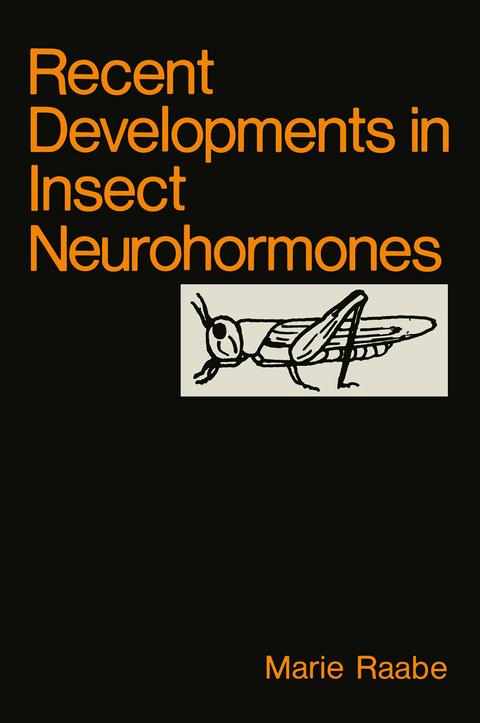
Recent Developments in Insect Neurohormones
Springer-Verlag New York Inc.
978-1-4612-8091-0 (ISBN)
1 Synthesis and Release Sites of Neurohormones.- 1.1. From the Original Concept of Neurosecretion to Contemporary Views.- 1.2. Classical Insect Neurosecretory Cells.- 1.3. Neurosecretory Pathways.- 1. 4. Release Sites.- 1.5. Regulation of Neurohormone Production and Release.- 1.6. Aminergic Neurons.- 1.7. Concluding Remarks.- 2 Vertebrate and Invertebrate Neuropeptides in Insects.- 2.1. Insect Neurons Immunoreactive to Vertebrate Peptide Antisera.- 2.2. Insect Neurons Immunoreactive to Invertebrate Neurohormones.- 2.3. Insect Neurons Immunoreactive to Insect Neurohormones.- 2.4. Distribution of Immunoreactive Products.- 2.5. Immunoreactive Neurons and Neurosecretory Cells.- 2.6. Cross-Reactions—Colocation of Immunoreactive Peptides.- 2.7. Concluding Remarks.- 3 Control of Prothoracic Gland Activity.- 3.1. Prothoracic Gland Innervation and Ultrastructure.- 3.2. Prothoracic Gland Degeneration.- 3.3. PTTH Assays.- 3.4. Timing of PTTH Release.- 3.5. PTTH Production and Release Sites.- 3.6. Purification of PTTH.- 3.7. PTTH Action Mechanism.- 3.8. Is PG Regulated by Factors Other Than PTTH?.- 3.9. Conclusion.- 4 Regulation of Corpora Allata Activity and Juvenile Hormone Titer.- 5 Diapause.- 5.1. Imaginal Diapause.- 5.2. Pupal Diapause.- 5.3. Larval Diapause.- 5.4. Embryonic Diapause.- 5.5. Purification of the Embryonic Diapause Factor.- 5.6. Conclusions.- 6 Reproduction.- 7 Muscle Activity.- 7.1. Visceral Muscles.- 7.2. Skeletal Muscles.- 7.3. Separation and Identification of Myotropic Peptides.- 7.4. Leucokinins, Leucopyrokinins, Leucomyosuppressins, and Leucosulfakinins.- 7.5. Action Mechanism of Myotropic Factors.- 8 Ecdysis and Tanning.- 8.1. Eclosion—Molting.- 8.2. Bursicon.- 8.3. Pupariation.- 8.4. Neurohormone Identification.- 8.5. Mode of Action.- 8.6. ConcludingRemarks.- 9 Pigment Synthesis and Breakdown—Color Change.- 9.1. Pigment Synthesis and Breakdown.- 9.2. Pigment Migrations.- 10 Osmoregulation.- 10.1. Methods.- 10.2. Diuretic Hormone.- 10.3. Biogenic Amines.- 10.4. Antidiuretic Hormone.- 10.5. Ion Metabolism.- 10.6. Juvenile Hormone and Ecdysone.- 10.7. Purification of Hormones Involved in Osmoregulation.- 10.8. Mode of Action of Hormones Regulating Osmoregulation.- 10.9. Conclusions.- 11 Metabolism.- 11.1. Lipid and Carbohydrate Metabolism.- 11.2. Protein Metabolism.- 11.3. Proteases and Amylases.- 11.4. Respiratory Metabolism.- 11.5. Origin and Release Sites of Metabolic Hormones.- 11.6. Mode of Action of Metabolic Hormones.- 11.7. Breakdown of Metabolic Hormones.- 11.8. Conclusion.- 12 Miscellaneous.- 12.1. Locomotor Activity.- 12.2. Flight.- 12.3. Endogenous Nerve Activity Stress.- 12.4. Polymorphism.- Concluding Remarks.- Addendum.- A.1. Synthesis and Release Sites of Neurohormones.- A.1.1. Neuroanatomical Studies.- A.1.2. Peripheral ns Ganglia.- A.1.3. Biogenic Amines.- A.2. Vertebrate and Invertebrate Neuropeptides in Insects.- A.2.1. Vertebrate Peptides.- A.2.2. Molluscan FMRFamide.- A.2.3. Insect Peptides.- A.3. Control of Prothoracic Gland Activity.- A.3.1. Hemolymph Protein Factor—Juvenile Hormone.- A.3.2. Ecdysteroid Production Outside Prothoracic Gland.- A.3.3. Brain-Ring Gland Interrelationships.- A.4. Control of Juvenile Hormone Activity.- A.4.1. Juvenile Hormone Diversity.- A.4.2. Azadirachtin.- A.4.3. Regulation by Octopamine of CA Synthetic Activity.- A.4.4. JH Binding Proteins and JH Esterases.- A.5. Embryonic Diapause.- A.6. Reproduction.- A.6.1. Vitellogenesis Regulation in Mosquitoes.- A.6.2. Vitellogenesis Regulation in Flies.- A.6.3. Vitellogenesis Regulation in Firebrats.- A.6.4. EmbryonicEcdysteroids.- A.6.5. A New Function for Oostatic Hormone.- A.6.6.Spermatogenesis.- A.7. Muscle Activity.- A.7.1. Hyperneural Muscle.- A.7.2. Modulatory Role of Proctolin.- A.8. Pigment Synthesis and Breakdown.- A.9. Osmoregulation.- A.9.1. Identification of Active Factors.- A.9.2. Biogenic Amines.- A.10. Metabolism.- A.10.1. AKH and Lipid Synthesis.- A.10. 2. New Members of the AKH Family.- A.10.3. Other Metabolic Factors.- A.10.4. Proteolytic Enzymes.- A.10.5. Mode of Action of Metabolic Hormones.- A.11. Miscellaneous.- References.- Species Index.
| Zusatzinfo | 484 p. |
|---|---|
| Verlagsort | New York, NY |
| Sprache | englisch |
| Maße | 152 x 229 mm |
| Themenwelt | Sachbuch/Ratgeber ► Natur / Technik ► Garten |
| Medizin / Pharmazie ► Medizinische Fachgebiete ► Neurologie | |
| Naturwissenschaften ► Biologie ► Evolution | |
| Naturwissenschaften ► Biologie ► Humanbiologie | |
| Naturwissenschaften ► Biologie ► Zoologie | |
| ISBN-10 | 1-4612-8091-5 / 1461280915 |
| ISBN-13 | 978-1-4612-8091-0 / 9781461280910 |
| Zustand | Neuware |
| Haben Sie eine Frage zum Produkt? |
aus dem Bereich


